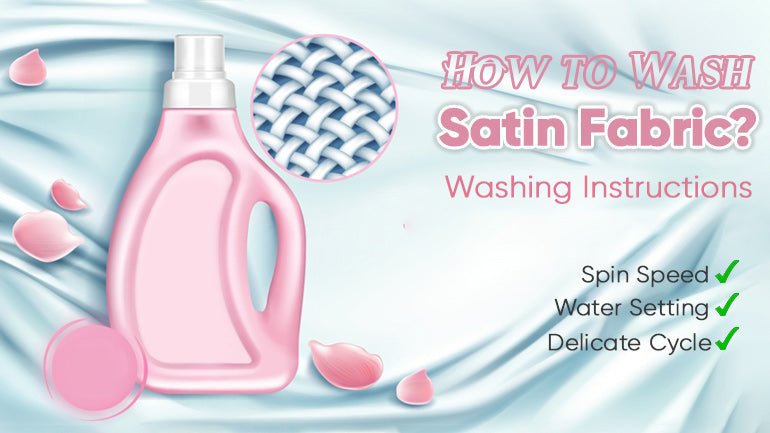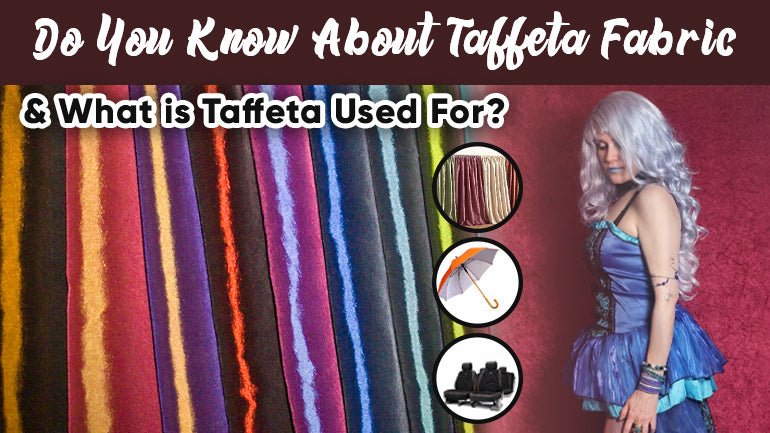Satin is a luxurious and elegant fabric that has been used for centuries in clothing, bedding, and other household items. The smooth and shiny texture of the satin fabric makes it a popular choice for special occasions such as weddings, proms, and other formal events.
What is Satin Fabric
Satin fabric is one of the most luxurious and comfortable fabrics in the world. It is a glossy and smooth material typically made from silk, polyester, or a blend of fibers. Satin is created through a weaving technique that produces long, floating yarns on the surface of the fabric, which are then either left as is or treated to create a high shine. But find exactly where does it come from?
A Brief History of Satin Fabric:
The origins of satin fabric can be traced back to the Chinese Han dynasty (206 BCE to 220 CE). During this time, the Chinese developed a technique for weaving silk threads into a smooth, lustrous fabric that was used for luxurious garments and bed linens. This fabric was known as "shu-shan," or "satin" in English.
Satin fabric soon spread to the West, where it became a popular choice for royal garments and religious vestments. In medieval Europe, satin was used to make elaborate gowns for the wealthy and powerful, and it was often embroidered with gold and other precious metals.
As the centuries passed, satin fabric evolved and diversified. Today, satin is made from a variety of materials, including silk, polyester, and rayon, and it is used for a wide range of purposes, from lingerie and bed linens to bridal gowns and formal wear. In this guide, we will explore the world of satin fabric, including its characteristics, uses, and care instructions.
What are the Characteristics of Satin Fabrics?
1. Smooth and Lustrous Surface:
The smooth and glossy surface of satin is what sets it apart from other fabrics. This is due to the tight weave and high thread count, which creates a smooth surface that reflects light beautifully. The lustrous surface of satin adds a touch of luxury to any item made from the fabric.
2. Soft and Silky Feel:
Satin has a soft, silky feel that is unmatched by other fabrics. This is because of the tight weave and high thread count, which creates a smooth and soft surface. The silky feel of satin makes it a popular choice for lingerie, sleepwear, and other clothing items that come into direct contact with the skin.
3. Durable and Long-lasting:
Despite its luxurious feel, satin is also a durable and long-lasting fabric. The tight weave and high thread count ensure that the fabric can withstand wear and tear and maintain its appearance for years to come.
4. Easy to Care for:
Satin is easy to care for and maintain, making it an ideal choice for those who want a luxurious fabric that is also practical. Satin can be machine washed and dried, and it can be ironed on a low heat setting to maintain its smooth and lustrous surface.
Expand your knowledge on How to Wash Satin Fabric.
The Best Uses of Satin Fabric
Satin fabric can be used for different projects including:
Uses of Satin Fabric in Fashion:
Satin is a popular fabric used in fashion due to its luxurious and elegant appearance. It is often used to make dresses, skirts, blouses, and lingerie. The silky smooth texture of satin provides a comfortable and soft feel, making it ideal for clothing that is in close contact with the skin.
Dresses:
Satin dresses are a popular choice for formal occasions, such as weddings and proms, due to their elegant appearance. Satin dresses are often available in a range of colors, including black, red, and white, and they are known for their ability to drape beautifully, creating a flattering and sophisticated silhouette.
Skirts:
Satin skirts are often used in the fashion industry due to their elegant and versatile appearance. They are available in a range of styles, including pencil skirts and A-line skirts, and they are often paired with blouses or tops made from other fabrics, such as silk or lace.
Blouses:
Satin blouses are a popular choice for both casual and formal occasions, and they are often used to create a sophisticated and stylish look. Satin blouses are available in a range of styles, including sleeveless, long-sleeved, and off-the-shoulder, and they are often paired with trousers or skirts.
Lingerie:
Satin is a popular fabric used in the production of lingerie due to its soft and luxurious feel. Satin lingerie is available in a range of styles, including bras, panties, and nightgowns, and it is often used to create a sensual and seductive look.
Read on to find out more about Is Sewing Satin Hard?
Uses of Satin Fabric in Home Decor:
Satin is not just limited to fashion, it is also used in home decor. Its luxurious and elegant appearance makes it a popular choice for bedding and curtains.
Bedding:
Satin bedding is a popular choice for those looking to create a luxurious and sophisticated look in their bedroom. Satin sheets and pillowcases are often available in a range of colors and sizes, and they provide a soft and smooth feel to the skin.
Curtains:
Satin curtains are a popular choice for those looking to add a touch of elegance to their home. They are often available in a range of colors and sizes, and they provide a glossy and sophisticated look to any room.
How many Types of Satin Fabric?
Satin fabric is a popular choice for many fashion designers, seamstresses, and textile artists, who often choose it for its soft, lustrous, and smooth surface. This fabric is made from different types of satin material including silk, polyester, rayon, and acetate, and it is typically used for high-end garments and accessories, such as bridal gowns, prom dresses, lingerie, and bed linens.
Types of Satin Fabric:
- Silk Satin: Silk satin is one of the most luxurious and sought-after types of satin fabric. It is made from the fibers of the silkworm, and it is prized for its soft and delicate texture, as well as its natural luster and sheen. Silk satin is ideal for use in high-end garments, such as bridal gowns, formalwear, and lingerie, as it is not only soft and smooth against the skin, but is also breathable and lightweight.
- Polyester Satin: Polyester satin is a popular choice for many fashion designers and manufacturers, as it is affordable, easy to care for, and widely available. This type of satin fabric is made from synthetic fibers, and it is known for its durability, resistance to wrinkles, and resistance to shrinkage and fading. Polyester satin is often used in casual and formal wear, as well as in home décor and textiles, such as curtains and bed linens.
- Rayon Satin: Rayon satin is another popular choice for many fashion designers and manufacturers, as it is relatively inexpensive and easy to care for. This type of satin fabric is made from cellulose fibers, and it is known for its smooth and soft texture, as well as its breathability and moisture-wicking properties. Rayon satin is often used in casual and formal wear, as well as in lingerie and bed linens.
- Acetate Satin: Acetate satin is a type of satin fabric that is made from cellulose fibers, and it is known for its soft and smooth texture, as well as its resistance to wrinkles and fading. This type of satin fabric is often used in formalwear, such as bridesmaid dresses, prom dresses, and evening gowns, as well as in home décor and textiles, such as curtains and bed linens.
- Nylon Satin: Nylon satin is a type of satin fabric that is made from synthetic fibers, and it is known for its strength, durability, and resistance to moisture and mildew. This type of satin fabric is often used in sportswear, activewear, and outdoor gear, as well as in lingerie and bed linens.
How to Take Care of the Satin Fabric?
The satin fabric has a smooth, lustrous, and soft feel to it, which makes it a popular choice for many people. However, it can be challenging to care for satin, as it requires special attention to keep it looking its best. Here we will take a comprehensive look at how to care for satin fabric, including proper cleaning and storage methods.
Cleaning Satin Fabric
Hand Washing Hand washing is the best and safest way to clean satin fabric. Fill a basin or sink with cool water and add a mild detergent. Gently agitate the fabric in the water, being careful not to rub or wring the fabric. Rinse the fabric thoroughly in cool water, and then gently squeeze out the excess water. Do not wring the fabric, as this can cause it to stretch or wrinkle.
Machine Washing If you must wash your satin fabric in a washing machine, use a gentle cycle and cool water. Use a mild detergent, and avoid using fabric softeners, as these can damage the fabric and cause it to lose its lustrous appearance. When the cycle is complete, gently remove the fabric from the machine and squeeze out any excess water. Do not wring or twist the fabric.
Drying Satin Fabric
Air Drying: The best way to dry satin fabric is to lay it flat on a clean towel, away from direct sunlight. Gently smooth out any wrinkles, and allow the fabric to air dry completely. Do not hang the fabric to dry, as this can cause it to stretch or wrinkle.
Tumble Drying: If you need to tumble dry your satin fabric, use a low heat setting and remove the fabric from the dryer as soon as it is dry. Do not over-dry the fabric, as this can cause it to become stiff and brittle.
Ironing Satin Fabric
Ironing satin fabric can be tricky, as the heat from the iron can cause the fabric to melt or become damaged. If you must iron satin fabric, use a cool iron and place a pressing cloth between the fabric and the iron. Iron on the reverse side of the fabric, and avoid ironing over any embellishments or decorations.
Storing Satin Fabric
Folding When storing satin fabric, fold it neatly and place it in a clean, dry location. Avoid stacking heavy objects on top of the fabric, as this can cause it to wrinkle or become damaged.
Hanging If you must hang your satin fabric, use a hanger that is designed for delicate fabrics. Avoid hanging the fabric in direct sunlight, as this can cause it to fade or become brittle.
Faqs
Is satin fabric natural or synthetic?
Satin fabric can be either natural or synthetic. Natural satin fabric is made from silk fibers while the synthetic satin fabric is made from polyester, nylon, or other man-made fibers.
Is satin good for hot weather?
Satin fabric is not the best choice for hot weather as it is a heavy and dense fabric. It may trap heat and make the wearer feel hot and uncomfortable. Lighter fabrics such as cotton or linen are better for hot weather.
Is satin good for winter or summer?
Satin fabric is better suited for winter than summer. It is a warm and insulating fabric that can keep the wearer warm in cold weather. However, it may not be suitable for summer as it is heavy and dense, trapping heat and making the wearer feel hot and uncomfortable.
Explore the depths of How can you wear Satin in the Summer.
What season is the satin fabric for?
Satin fabric is typically considered a winter fabric. It is warm and insulating, making it ideal for cold weather. However, it can also be used in other seasons, such as autumn, when temperatures are cool.
Is satin only for winter?
No, satin is not only for winter. It can be used in other seasons as well, such as autumn, when temperatures are cool. However, it is not recommended for hot weather as it is a heavy and dense fabric that can trap heat and make the wearer feel hot and uncomfortable.
Is satin good to sleep in?
Satin fabric can be good to sleep in as it is soft and smooth against the skin. However, some people may find it too warm and heavy, especially in hot weather. It is recommended to opt for lighter fabrics such as cotton or linen for sleeping in hot weather.
Is satin fabric waterproof?
No, the satin fabric is not waterproof. It is a dense and heavy fabric that is not suitable for outdoor activities or activities that may involve getting wet. For outdoor activities, it is recommended to opt for waterproof fabrics such as Gore-Tex or synthetic fabrics.



